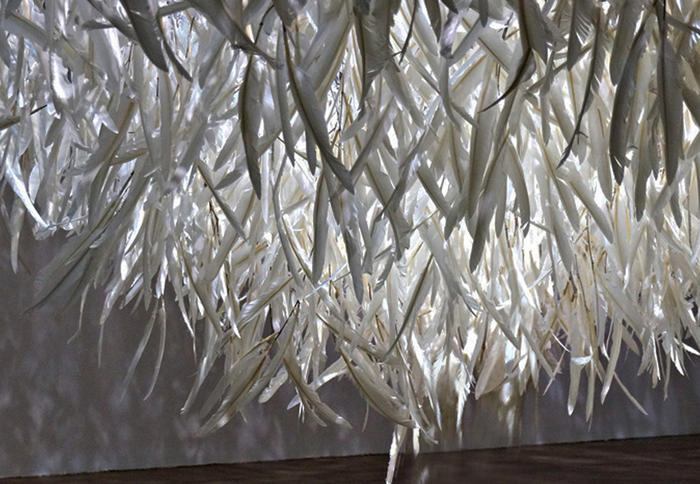美術館【蒹葭蒼蒼】— 游文富個展 /【Boundless Feather Field】 Yu Wen Fu Solo Exhibition

展覽時間:2023. 11.01(三)~ 11.26(日)(應觀眾要求,延長展期兩日,請把握觀展機會) / 藝文總中心美術館綜二館展廳 地圖
展覽開幕:2023. 11.01(三)16:00 / 藝文總中心美術館綜二館展廳
藝術家面對面:2023. 11.01(三)16:30 / 藝文總中心美術館綜二館展廳
平日12:00-18:00 / 周末12:00-17:00 / 國定假日休館一日
游文富成名於2001年台灣澎湖的地景藝術 ”讓山飛行”;一望無際的山丘上夾染著延綿數千米成海的羽毛竹子,在蘆葦中舞動,澎湖風大,羽毛遂成為河流動著,那段日子,澎湖的山丘是與風吟唱的;土地存載了詩歌的記憶。
當代藝術看似冷漠及無用;選用的材質是每個藝術家的必爭之地,是行走江湖的斗篷,一路行來赫赫有風;游文富的有些作品是與當地的婦女一起勞動而成,並為土地的農產品提升了物質價值。一舉數得是當代藝術應給這世道的金剛經。
清華的抽象羽系,是雲朵,是蒹葭蔞蔞,是白露為霜,有性情的,有感覺的,是場域裡的風景。 這個種植羽毛的男人,一頭蓬鬆亂髮,蓄短鬚,笑靦腆,但直爽;口音帶著濃厚的閩南口音,手上厚實的繭,是常年與羽竹子打交道的結果。
他是個與土地共舞的頑童,也是個彎腰十萬次迎風的藝術家,這種以手工繁複的簡單動作,揚棄心的繁瑣,達到心理的平靜,如同反覆誦經,是單純的純粹。
這個展覽得以實現是需要感恩的,感恩藝術家的認同清華,感恩時間,感恩大地萬物得羽化為藝術的志氣清堅。
Exhibition:2023. 11.01(Wed.)~ 11.26(Sun.)(Exhibiition extends for 2 days) / NTHU Center for Arts and Culture_General Building 2 (1F) Map
Opening:2023. 11.01(Wed)16:00 / NTHU Center for Arts and Culture_General Building 2 (1F)
Meet the Artist:2023. 11.01(Wed)16:30 / NTHU Center for Arts and Culture_General Building 2 (1F)
Weekdays 12:00-18:00 / Weekends12:00-17:00 / National Holidays Closed
Yu Wen Fu is renowned for "Let the Mountains Fly" in Taiwan Penghu 2001 Landscape Art Festival. On the vast hills, thousands of kilometers of feather bamboo intermingled with reeds, dancing in the strong Penghu wind. The feathers seemed to flow like a river, and during that time, the hills of Penghu sang with the wind, holding the memories of poetry within the land. Contemporary art may seem indifferent and useless at times, but the choice of materials is the battleground for every artist. Some of Yu Wen Fu's artworks were created through labor with local women, elevating the material value of the land's agricultural products, feathers and bamboos. This contemporary art is like the sutra that calms people’s minds.
The series at Tsinghua of abstract feather resembles clouds, luxuriant grass, and frost on leaves. It reveals the feeling of landscape. The artist has disheveled hair, a short beard, a shy smile, straightforward personality, and has thick Taiwanese accent. After years of dealing with feather bamboo, making his hands calloused. He's like a playful child who dances with the land and an artist who bows a hundred thousand times to the wind. These simple, labor-intensive movements are a departure from the complexity of the mind, leading to psychological tranquility, much like reciting scripture repeatedly—a pure simplicity.
This exhibition's realization is a reason for gratitude, grateful for the artist's recognition of Tsinghua, grateful for time, and grateful for the unwavering artistic spirit that transforms everything from the earth into art with pure determination.